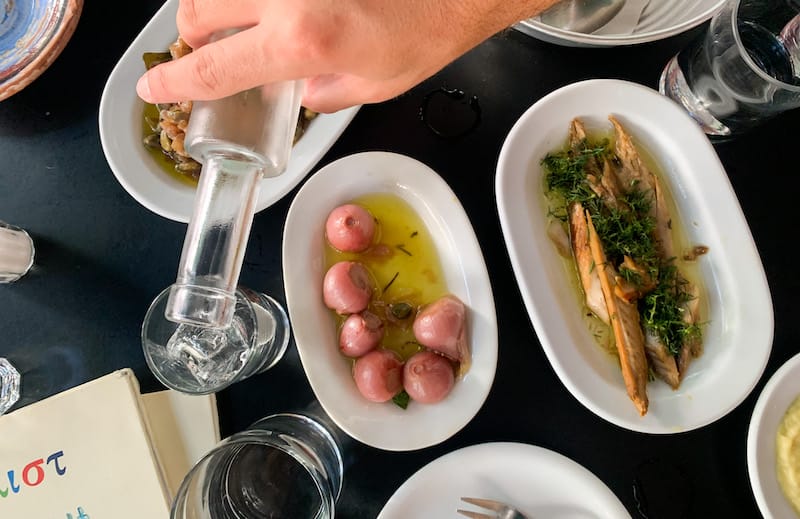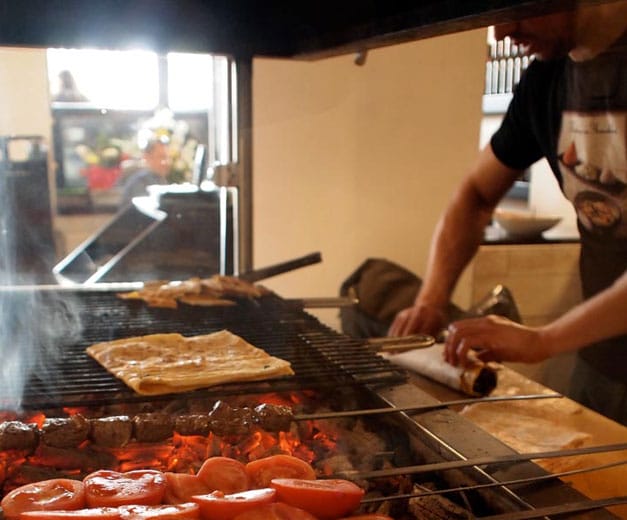Ghana and Sicily may not seem like a natural fit, but they come together perfectly at Hama, a Palermo restaurant that brings the two places’ cuisines together while also offering an edible lesson about Sicily’s centuries-old role as a meeting point between Europe and Africa.
The name Palermo derives from the ancient Greek panormos and refers to any place where a boat can be docked easily. As a gateway to Europe, Sicily has been a cultural melting pot for many centuries. Today, this long history of cultural and social interactions is woven into the fabric of the city: as street names, as linguistic particularities, and culinary specialties. Migration from Asian and African countries is particularly evident in Sicilian life, especially here in Palermo. Ghana, in particular, is one country whose influence can be felt in the city. Though geographically farther away than some other northern African countries, Ghanaians constitute one the largest diasporas in Palermo today.
Although the boat may be anchored here without much difficulty, some of its passengers must overcome numerous obstacles to live here. We met with Azzurra Pucci and Mohammed Musah, owners of the wonderful Hama, a Ghanaian restaurant located near Palermo’s main railway station, an area which is home to many of the city’s international eateries, to hear more about the perilous and complicated journeys that many Ghanaians undertake before reaching Palermo.
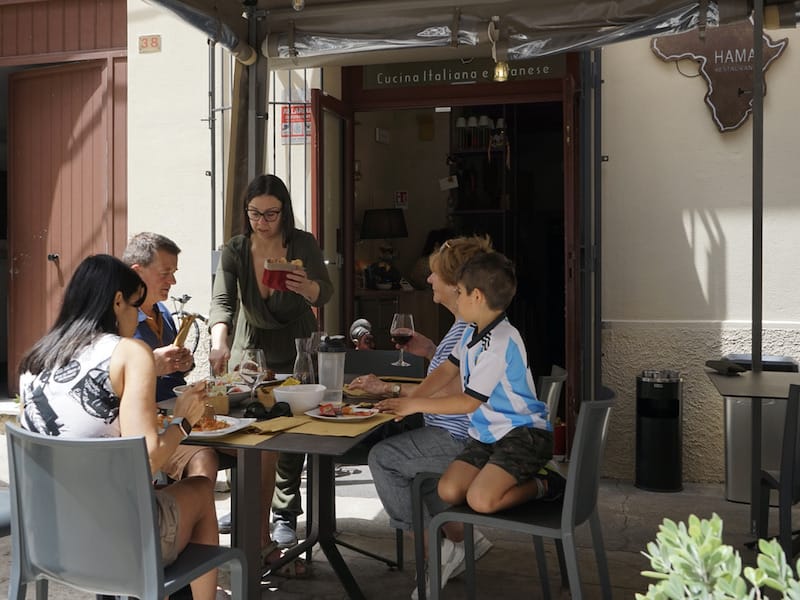
Mohammed knows because he has lived through it: “First I went to Libya; we go there to gather money to pay for the upcoming travel and have some financial resources once we reach our destination,” he told us. “As it was still possible [at the time], one would then go to Syria and finally arrive in Palermo – now, it’s a bit more complicated. As for me, it was still possible to travel to Syria and then arrive in Palermo. Now with the war, things have changed and it is even harder.”
Mohammed reached Palermo in 2005. He and Azzurra – who is from Palermo – met at a restaurant they used to work at together. They soon decided to start a venture together. The two decided to use their unique experiences to create one that was common: Hama. The name combines the initials of Mohamed and Azura’s families, and the restaurant, which opened in the spring of 2022, represents and emphasizes unity and solidarity between people.
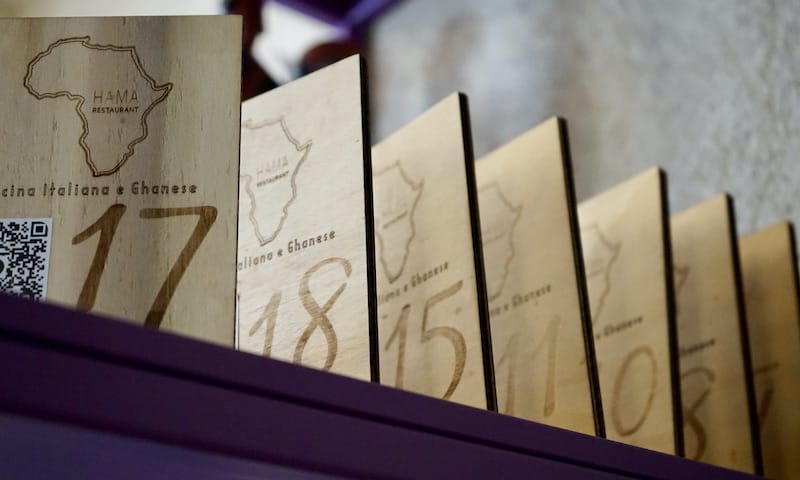
Their main goal for Hama is to familiarize Palermitans with the cuisine and culture of one of the largest diasporas among them, but the restaurant does so much more than that. Serving food from both Sicily and Ghana, Azzura and Mohammed demonstrate and emphasize the subtle points of contact between these seemingly disparate cultures. The space itself has been decorated and designed in a similar manner: the look and feel of a typical Italian restaurant coupled with various pieces of artwork and artifacts from Ghana.
Like the atmosphere in the restaurant, the food is simple but well-balanced. A diverse tapestry of culinary expertise weaves its way through the kitchen brigade, Badù, Philip and Alice, all Ghanaian hailing from various regions, bear with them distinct culinary and cultural traditions. Philip and Alice come from the southern part of the country, where Christianity prevails, while Badù, like the co-owner Mohammed, originates from the northern terrain, which has a larger Muslim population. While region and religion in Ghana may have the potential to sow division, within these walls, it transforms into a powerful rallying point, unifying the team who utilizes their diverse experiences to offer a holistic Ghanaian culinary experience. Today, Philip is preparing the fish for both Sicilian and Ghanaian recipes. In our conversation, Philip sheds light on the culinary visionary behind their dishes: “We buy what the market has to offer and adapt the recipes according to what’s available. Sardines, shrimp, and other seafood are our reliable go-tos. Today, for example, we managed to get our hands on some red mullet, which will be perfect for our Sicilian frittura mista di pesce, a mouthwatering mixed fried fish dish.”

At Hama, fish takes center stage, commanding attention in both Sicilian and Ghanaian culinary traditions – the same fish, but with different flavors. The restaurant’s pasta dishes proudly showcase the flavors of the sea such as clams in pasta con vongole or mussels in pasta con cozze. The Sicilian pasta alla marinara, bathed in a simple yet expertly prepared tomato sauce with olive oil, garlic, basil and oregano, stands alone on their menu as the sole first course devoid of any hints of the sea.
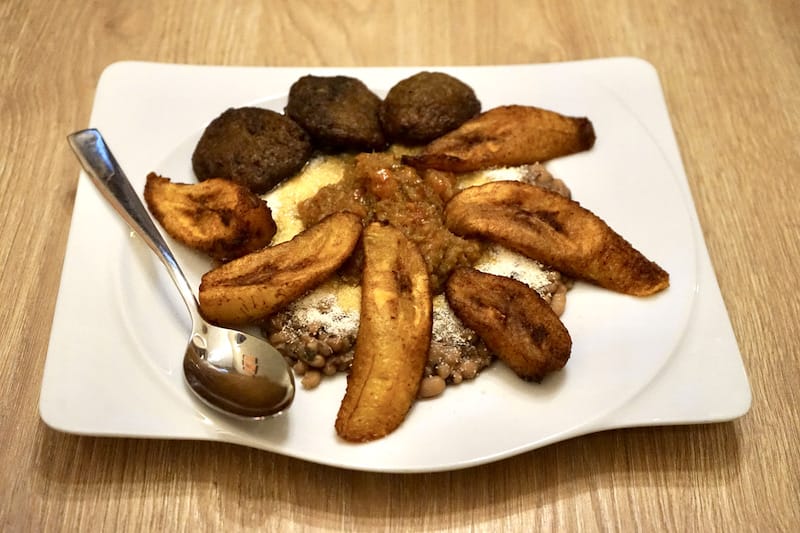
The Ghanaian recipes include fish or chicken as options for rice dishes such as wakye or jollof rice. Hama’s Ghanaian dishes also boast one of their most pungent ingredients – shito, a Ga term for black pepper. This fiery sauce is a delightful accompaniment to the fried yams, a root cherished across Africa, South America, Asia, and Oceania, known for its starchy and earthy character. In addition to the fried yams, the gari and beans are another excellent vegetarian option, made from coarse, toasted cassava flour and red beans. The gari is served with crunchy plantains, the sweetness of which gives a kick to the mildly nutty taste of the beans.
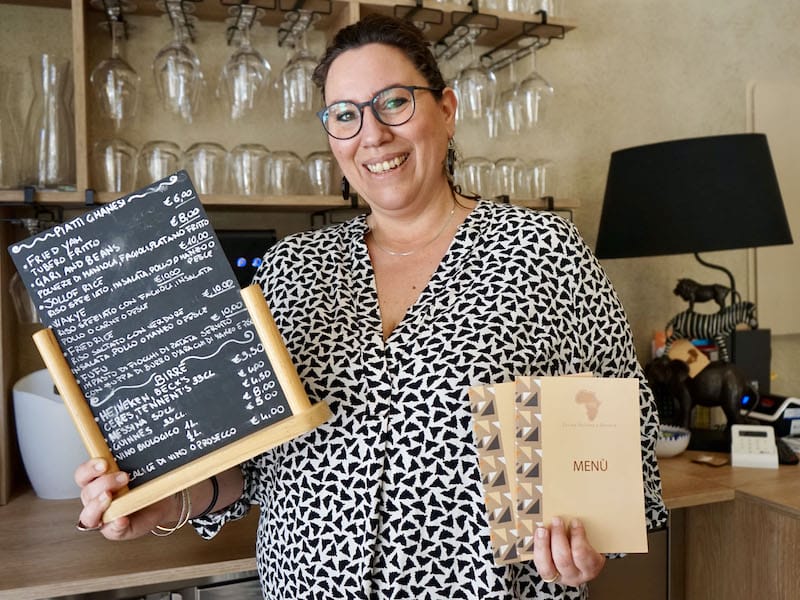
Rossela, one of the customers adds: “The first time I came I had no clue about the food eaten in Ghana, now the fufu is part of my monthly diet.” The fufu is a popular dish in West and Central Africa with many regional variants. Fufu can be created from a variety of starchy ingredients. Although cassava root or yams are the traditional choices in Ghana, the innovative twist found in Hama introduces a new rendition, utilizing potato starch and potato flakes. This smooth and sticky dough is served alongside flavorful meat and fish stews. This is the dish we like to go for at Hama.
Philip further shares that both Sicilian and Ghanaian cuisines rely on few ingredients, reflecting the concept of cucina povera, or the “kitchen of the poor.” He explains, “[In Sicily] it is called the cucina povera, and that’s what I found even more interesting: making such flavorful dishes out of so little. And the same goes for Ghana. It’s not like we had access to so many products. Now, with globalization and so on, it has changed, but the cuisine remains the same: minimalistic but tasty.” Chuckling, he adds, “The Ghanaian one is only a little spicier.”
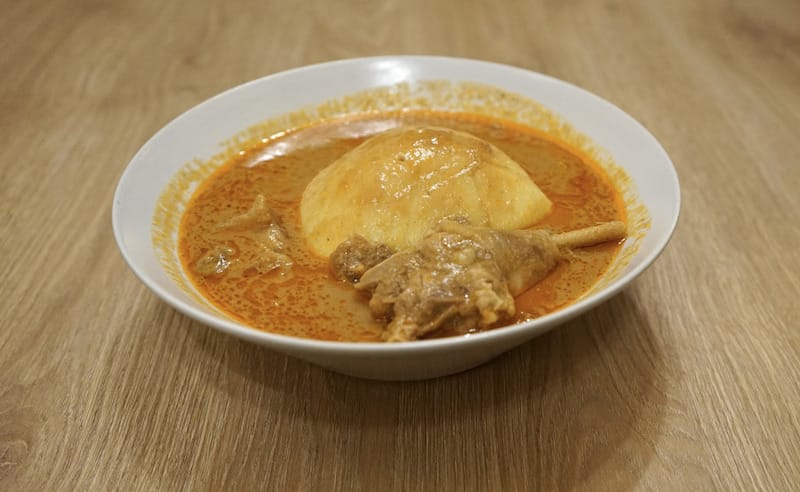
Alice is the specialist for Ghanaian cuisine at Hama. She cooks exclusively Ghanaian recipes, explaining: “For me, it’s not only about the food I’m preparing; it’s all the memories I have with my family, friends and acquaintances in Ghana. As I cook, I can have this feeling of home again.” Azzurra, Mohammed, and occasionally a friend of theirs named Lucie all work in the dining area. There is a cozy, homey atmosphere and a calm air. Azzurra points out that this respect for social relations is yet another similarity between Ghana and Sicily. “Here, we take our time, converse, and truly connect with the guests,” she says.
As we talk with the customers during their Sunday lunch, Salvatore, a regular customer, tells us, “The beautiful thing about this place is that in addition to the food, one can learn a lot about history and migration. Since the whole team has visited Ghana, they always have a story to share that helps us better comprehend Sicily’s multiethnic population.
In a mesmerizing fusion of Ghanaian and Sicilian flavors, Hama captivates the senses, intertwining a vibrant exchange of cultures. With each dish carefully crafted to showcase the richness of both Ghanaian and Sicilian traditions, the restaurant becomes a dynamic symbol of multiculturalism within the city. The owners’ unwavering mission of sharing Ghanaian and Sicilian food and culture creates a vibrant and inclusive dining experience, fostering connections and celebrating the diverse heritage that enriches the culinary landscape. By embracing the beauty of cultural exchange, Hama stands as a shining example of the city’s multicultural philosophy, reminding us that through food, we can bridge gaps, celebrate diversity, and create a harmonious tapestry that nourishes both body and soul.
 June 9, 2017 Andro Barnovi
June 9, 2017 Andro Barnovi
Drive west of Tbilisi for about an hour on the backroad to Gori and you will find […] Posted in Tbilisi June 13, 2022 To Hohlidaki
June 13, 2022 To Hohlidaki
Even though Athens is fairly close to the sea, there are times when we crave a quick […] Posted in Athens February 7, 2014 Antiochia
February 7, 2014 Antiochia
Editor’s note: Antiochia has moved to a new location.
In Istanbul, we’ve noted an […] Posted in Istanbul
Ségolène BulotSégolène Bulot
Published on June 16, 2023
Related stories
Join us for an exclusive visit to this winery followed by a village-style feast.
June 9, 2017
TbilisiDrive west of Tbilisi for about an hour on the backroad to Gori and you will find yourself in the heart of the Shida Kartli wine region. It is an awesome expanse of plains, rolling hills, jagged ridges and hidden valleys that provide a myriad of terroirs that grow some of Georgia’s most exclusive grapes.…
June 13, 2022
Athens | By Katherine Whittaker
AthensEven though Athens is fairly close to the sea, there are times when we crave a quick island getaway – to taste the best tomato salads of the Cyclades, or one of the many pungent cheeses of Naxos, or real smoked apaki from Crete, but we don’t have the time (or resources) to venture out…
February 7, 2014
IstanbulEditor’s note: Antiochia has moved to a new location. In Istanbul, we’ve noted an inverse relationship between a restaurant’s atmosphere and what’s coming out of the kitchen. In most cases, as furniture design goes slick, as bathrooms get properly lit and ventilated, as the wait staff becomes customer-savvy, the quality of the kitchen inevitably goes…



















































